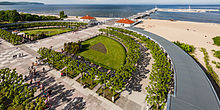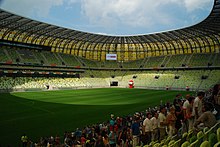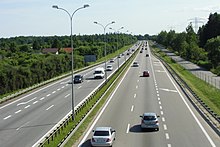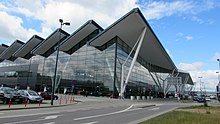| Tricity Trójmiasto | |
|---|---|
| Urban area | |
       | |
 Powiats of Gdansk, Gdynia and Sopot (in red) Powiats of Gdansk, Gdynia and Sopot (in red) | |
 | |
| Coordinates: 54°26′N 18°33′E / 54.433°N 18.550°E / 54.433; 18.550 | |
| Country | Poland |
| Voivodeship | Pomeranian |
| Government | |
| • Mayor of Gdańsk | Aleksandra Dulkiewicz |
| • Mayor of Gdynia | Aleksandra Kosiorek |
| • Mayor of Sopot | Magdalena Czarzyńska-Jachim |
| Area | |
| • Urban area | 414.81 km (160.16 sq mi) |
| Population | |
| • Urban area | 749,786 |
| • Density | 1,806/km (4,680/sq mi) |
| • Metro | 1,098,379 |
| GDP | |
| • Urban area | €23.781 billion (2021) |
| Time zone | UTC+1 (CET) |
| • Summer (DST) | UTC+2 (CEST) |
| Area code | +48 058 |
| Car Plates | GA, XA, GD, XD, GSP |



Tricity, or Tri-City (Polish: Trójmiasto; Polish pronunciation: [trujˈmʲastɔ], Kashubian: Trzëgard; Kashubian pronunciation: [tʂəɡart]; German: Dreistadt), is an urban area in Pomeranian Voivodeship, Poland, consisting of three contiguous coastal cities in Pomerelia forming a row on the coastline of the Gdańsk Bay, Baltic Sea, namely the cities of Gdańsk, Gdynia, and Sopot, along with other cities and towns in their vicinity. In 2021, the three core cities were inhabited by 749,786 people, while the Tricity together with its metropolitan area had a combined population of between 1 and 1.5 million, depending on the definition of the boundaries of the latter.
The designation has been used informally or semi-formally only. A strategic cooperation declaration, the Tricity Charter (Polish: Karta Trójmiasta), was signed by the three city mayors on 28 March 2007. The only incorporated common management authority in the Tricity metro is the Gdańsk Bay Public Transport Metropolitan Union (Polish: Metropolitalny Związek Komunikacyjny Zatoki Gdańskiej) which is, despite the name, an inter-municipal union and not a metropolitan one.
Economy
Nearly 35% of taxpayers from Tricity are in the middle and high taxable income groups (average for Poland 10%). Approximately 12% of Tricity taxpayers are in the highest taxable income group (Polish average 3%).
Population
The total population of the 3 cities comprising Tricity (Gdańsk + Gdynia + Sopot):
- XII.1960: 481,100 inhabitants (286,900 + 150,200 + 44,000)
- XII.1970: 604,800 inhabitants (365,600 + 191,500 + 47,700)
- XII.1975: 693,800 inhabitants (421,000 + 221,100 + 51,700)
- XII.1980: 744,400 inhabitants (456,700 + 236,400 + 51,300)
- XII.2004: 754,960 inhabitants (460,524 + 253,650 + 40,785)
- XII.2006: 748,126 inhabitants (456,658 + 251,844 + 39,624)
- XII.2019: 752,954 inhabitants (470,907 + 246,348 + 35,719)
- XII.2021: 749,786 inhabitants (470,633 + 244,104 + 35,049)
The Tricity metropolitan area also includes Wejherowo, Reda, Rumia, Pruszcz Gdański, and several other communities. The total population in 2006 was 1,100,500, in an area of 1,580.69 km.
The Tricity continuous urban area includes the following cities:
| City | Area 1996 km |
Area 2017 km |
Pop. 1996 | Pop. 1999 | Pop. 2003 | Pop. 2019 | Pop. 2023 |
|---|---|---|---|---|---|---|---|
| Gdańsk | 265.03 | 261.96 | 462,336 | 457,937 | 461,011 | 470,907 | 486,492 |
| Gdynia | 135.49 | 135.14 | 251,932 | 255,014 | 253,500 | 246,348 | 242,141 |
| Sopot | 17.31 | 17.31 | 43,360 | 42,333 | 41,017 | 35,719 | 32,115 |
| Pruszcz Gdański | 16.47 | 16.47 | 21,470 | 21,757 | 23,187 | 31,326 | 32,093 |
| Rumia | 32,86 | 30.10 | ? | 40,200 | 43,000 | 49,230 | 52,931 |
| Reda | 26.39 | 33.46 | 15,422 | 17,510 | 17,868 | 26,307 | 28,588 |
| Wejherowo | 25.65 | 26.99 | 47,357 | 47,038 | 46,900 | 49,505 | 46,271 |
| Total | 513.42 | 504.96 | 882,871 | 884,080 | 885,240 | 909,342 | 920,631 |
According to official EU publication the population of Larger Urban Zone of Tricity is 1,098,379.
Education
Tricity is an important center of education.
- Gdańsk: Number of universities: 13 (2010) Number of students: 52,436 (2009) Number of graduates: 10,439 (2001)
- Gdynia: Number of universities: 7 (2010) Number of students: 21,362 (2010)
Some of the universities in the Tricity:
- Academy of Physical Education in Gdańsk
- Academy of Fine Arts in Gdańsk
- Academy of Music in Gdańsk
- Gdynia Maritime University
- Polish Naval Academy in Gdynia
- Medical University of Gdańsk
- University of Gdańsk
- Gdańsk University of Technology
- SWPS University in Sopot
- Sopot University of Applied Sciences
- Gdańsk School of Banking
- Gdańsk Management College
- Gdańsk Higher School of Humanities
- Gdańsk Administration School
- Social Economic Higher School in Gdańsk
- The Higher School of Tourism and Hotel Industry in Gdańsk
- Academy of International Economic and Political Relations in Gdynia
- Kwiatkowski University of Business and Administration in Gdynia
- Pomeranian Higher School of Humanities in Gdynia
- The Higher School of Physical Culture and Tourism in Sopot
- Sopot College
Entertainment
Cinemas:
- Gdańsk Film Centre (studio cinemas; all three closed in 2015)
- Helikon
- Kameralne
- Neptun
- Helios Gdańsk Alfa
- Helios Gdańsk Forum
- Helios Gdynia
- Kameralne Cafe
- Kinoplex
- Multikino Gdańsk
- Multikino Sopot
- Multikino Rumia
- Gdyńskie Centrum Filmowe
- Polonia
- Żak
Theatres:
- Wybrzeże Theatre
- Danuta Baduszkowa Musical Theatre in Gdynia
- Witold Gombrowicz Municipal Theatre in Gdynia
- Atelier Theatre in Sopot
- Dreams Theatre
- Miniatura Theatre in Gdańsk
- Theatre Znak in Gdańsk
- Wybrzeżak Theatre
- Gdańsk Shakespeare Theatre
- Scena Kameralna Teatru Wybrzeże
- Summer Scene of Gdynia's Municipal Theatre
- Scena Teatralna ŻAK
- Theatrum Gedanense Foundation
Opera house and Philharmonic
- Forest Opera in Sopot
- Polish Baltic Philharmonic
- Polska Filharmonia Kameralna in Sopot
- Baltic Opera
Museums and art galleries
- Gdańsk City Gallery
- Chodowiecki and Grass House
- Państwowa Galeria Sztuki in Sopot
- National Museum
- Zbrojownia Sztuki
- Art Cybernetics Institute (ICS)
- CSW Łaźnia
- Art Lab Wyspa
- multiple small noninstitutional galleries (Galeria UL, Tajna Galeria, Brama Wyżynna, KIT)
- Museum of the Second World War
- National Maritime Museum, Gdańsk
Climate
Tricity has a temperate climate with warm summers and mild winters. The climate regime differs significantly between cities with Gdańsk belonging to a humid continental climate (monthly mean temperature below zero for two months a year) and Gdynia to oceanic climate (no monthly mean temperature below freezing) according to Koppen-Geiger classificiation. Rain is possible all year round. Autumns are warmer than springs due to the warming effect of the adjacent Baltic Sea. Winters are wet, windy and mild, compared to the interior of Poland. Sea temperatures have been rising significantly during last decades prolonging the summer season to five months in recent years.
| Climate data for Tricity (Gdańsk) | |||||||||||||
|---|---|---|---|---|---|---|---|---|---|---|---|---|---|
| Month | Jan | Feb | Mar | Apr | May | Jun | Jul | Aug | Sep | Oct | Nov | Dec | Year |
| Mean daily maximum °C (°F) | 0 (33) |
0 (33) |
4 (40) |
9 (49) |
15 (60) |
18 (66) |
20 (69) |
20 (69) |
16 (61) |
11 (52) |
5 (41) |
1 (35) |
10 (50) |
| Mean daily minimum °C (°F) | −4 (24) |
−4 (24) |
−1 (29) |
1 (35) |
6 (43) |
9 (49) |
11 (53) |
11 (53) |
8 (47) |
4 (40) |
0 (33) |
−2 (28) |
3 (38) |
| Average precipitation mm (inches) | 38.1 (1.5) |
27.9 (1.1) |
27.9 (1.1) |
30.5 (1.2) |
43.2 (1.7) |
55.9 (2.2) |
71.1 (2.8) |
71.1 (2.8) |
61.0 (2.4) |
48.3 (1.9) |
55.9 (2.2) |
45.7 (1.8) |
576.6 (22.7) |
| Source: Weatherbase | |||||||||||||
Sport
Main article: Sport in Tricity
Tricity has a number of professional teams, which compete in basketball, volleyball, speedway, handball, rugby union and football.
The most known football clubs, contesting the Tricity Derby, are Lechia Gdańsk and Arka Gdynia.
Both clubs also possess highly successful rugby teams, RC Arka, who play at the National Rugby Stadium and RC Lechia. There is a third top-flight Polish rugby team Ogniwo Sopot, making the Tricity Poland's rugby capital.
The third football club is Bałtyk Gdynia, in the past also a multi-sports club with over 20 different sections.
Wybrzeże Gdańsk are the Tricity's speedway team, formerly a multi-sports club, now its only other remaining section is the reactivated handball team, former ten-times men's Polish champions.
Arka also fields a men's and women's professional basketball team while Trefl Sopot is the other men's professional basketball club in the Tricity.
Stoczniowiec Gdańsk is the local ice hockey team.
Transport

The Tricity has a well-developed traffic infrastructure and public transport system. Development of the Tricity was smoothed by the construction of the rapid transit rail (SKM) 1951, binding the whole area from Tczew by Gdańsk, Sopot 1953, Gdynia 1956, Reda, Rumia to Wejherowo 1957. In 1975, the Tricity Beltway was constructed.
The Gdańsk Bay Public Transport Metropolitan Union (MZKZG), a body incorporated by the municipalities in the area to act as a common public transport authority, issues tickets valid both for the SKM Rapid Transit Rail, as well as for all or some of the trams and buses in Gdańsk or trolleybuses and buses in Sopot and Gdynia.
Road transport
The backbone of the Tricity is the inner highway. It starts in Gdańsk and goes through Sopot, Gdynia, Rumia and Reda to Wejherowo. It consists of 2-4 lanes in each direction.
The dual carriageway Tricity Beltway (Obwodnica Trójmiejska) starts in the vicinity of Pruszcz Gdański and goes through the western districts of Gdańsk to Gdynia-Chylonia.
Trolleybus, bus and coach
The variety and number of public bus lines and coach connections facilitates the travel around the Tricity and surrounding areas. One of the most popular means of transport in the Pomerania province is the public coach. The high number of bus lines covers every quarter of the three cities within the metropolis. In addition to usual buses, Gdynia also operates trolleybuses which reach Sopot.
Rail transport
Tramway
The city of Gdańsk operates a well-developed tram system.
Tricity Rapid Transit Rail
The Tricity area is served by the SKM rail network (known in Polish as Szybka Kolej Miejska w Trójmieście or "Tricity Rapid Transit Rail"). It currently provides regular service primarily on two dedicated railways complemented by some of the ordinary railways in the region, both as a commuter rail connecting some of the peripheral towns and villages with each other and with the principal cities of Gdańsk, Gdynia and Sopot, as well as internal rapid transit service within the urban core formed by the three cities. The intervals range from every 6 minutes during peak time on the main common section between Gdańsk and Gdynia to 30 minutes at the farthest ends.

The rapid transit rail network has achieved since its inception in 1951 a unifying effect on the metro area formerly divided by a frontier, by linking the connected localities with a frequent and reliable service. More recently, a pre-war railway destroyed in 1945 by the retreating German army has been reconstructed as the 19.5 km Pomorska Kolej Metropolitalna (Pomeranian Metropolitan Railway) or PKM line, also been operated by the SKM, and put into service in 2015, providing connection of the downtown station of Gdańsk Wrzeszcz Station with the Gdańsk Lech Wałęsa Airport, with further service to the Gdynia Główna Station provided via an earlier existing railway, thus forming a loop connected to the primary SKM line directly at its southern terminus, while the northern terminus is connected indirectly through an earlier existing line. The primary SKM line has been served by overhead-powered electrical multiple units since its inauguration, while the PKM line is currently serviced by oil-powered units, though it is scheduled for imminent electrification.
Regional rail connections and remote rail destinations
The area is well connected to the rest of the Pomerania region, as well as Poland and the rest of Europe. Polregio network provides a regional rail service connecting the cities and towns of the Pomerania. Gdańsk Główny and Gdynia Główna serve as major rail hubs for the area, with these stations and five others, Gdańsk Wrzeszcz, Gdańsk Oliwa, Sopot, Wejherowo and Rumia offering inter-city services to cities around Poland and in other countries, operated by Polish State Railways under the PKP Intercity branding. Most of the stations that are served by regional and inter-city rail are also part of the above-mentioned SKM network.
Air transport

Gdańsk Lech Wałęsa Airport is one of the three busiest Polish international airports. Its position is associated with a well-developed network of domestic and international transport connections provided in response to the growing demand for business and tourist travel.
The Gdańsk Airport is located 10 km from the centre of Gdańsk, about the same distance from the centre of Sopot and 23 km from the centre of Gdynia. The continually expanding road system which connects the airport with the city centres allows drivers to cover the distances in about 15–20 minutes. The close vicinity of the Tri-city by-pass and junctions with state motorways nos. 1, 6 and 7 facilitates access from areas outside the Tri-city. The convenient location of the airport makes it easy for travellers and cargo carriers to transfer from air to road, and also to the railway network and seaports. Gdańsk Lech Wałęsa Airport has its own railway siding which can be used for handling large lots of cargo dispatched by air.
The Gdańsk Airport operates even the biggest planes and allows thousands of tourists to visit the Pomerania province every day. Just in front of the main entrance to the passenger terminal, the visitors can find a bus that will take them to the city centre. There are frequent SKM trains running from the train station in front of the airport to Gdynia, Gdańsk Wrzeszcz, Kartuzy and Kościerzyna. A passenger may also choose to take a taxi.
A failed attempt was undertaken to partially repurpose the Military Gdynia-Kosakowo Airport into a dual-use military and civil one.

Scheduled passenger destinations
- Ålesund (WizzAir)
- Aarhus (Eurolot)
- Aberdeen (WizzAir)
- Amsterdam (Eurolot)
- Belfast (EasyJet)
- Barcelona Girona (WizzAir)
- Birmingham (Ryanair)
- Bournemouth (WizzAir)
- Bremen (Eurolot)
- Bristol (EasyJet)
- Cardiff (bmibaby)
- Cologne / Bonn (WizzAir)
- Copenhagen (SAS and Ryanair)
- Cork (Ryanair)
- Coventry (WizzAir)
- Doncaster Sheffield (WizzAir)
- Dortmund (WizzAir)
- Dublin (Ryanair)
- East Midlands Airport (bmibaby)
- Eindhoven (WizzAir)
- Frankfurt (LOT, Lufthansa)
- Frankfurt Hahn (Ryanair)
- Glasgow Prestwick (WizzAir)
- Gothenburg (WizzAir)
- Hamburg Lubeck (WizzAir)
- Haugesund (WizzAir)
- Helsinki (Finnair)
- Iraklion (LOT)
- Karlskrona Ronneby
- Katowice (Eurolot)
- Kraków (Eurolot)
- Leeds Bradford Airport (Ryanair)
- Liverpool (WizzAir)
- London Gatwick Airport (EasyJet)
- London Luton Airport (WizzAir)
- London Stansted Airport (Ryanair)
- Malmö Airport (WizzAir)
- Munich (LOT)
- Oslo (Norwegian, SAS)
- Oslo Torp (WizzAir)
- Poprad (Eurolot)
- Salzburg (Eurolot)
- Stockholm Skavsta Airport (WizzAir)
- Turku (WizzAir)
- Vilnius (AirBaltic)
- Warsaw (LOT)
Maritime transport
Scheduled ferry lines
- Gdynia - Karlskrona - Gdynia (Stena Line)
- Gdynia - Hanko (Finnlines)- freight service only
- Gdańsk - Nynashamn - Gdańsk (Polferries)
Foreign representatives
Gdańsk:
- Consul of the Kingdom of Denmark
- General Consulate of China
- General Consulate of Russia
- General Consulate of the Republic of Belarus
- General Consulate of the Federal Republic of Germany
- General Consulate of Ukraine
- Honorary Consul of the Federal Democratic Republic of Ethiopia
- Honorary Consul of the United Kingdom
- Honorary Consul of the Republic of Latvia
- Honorary Consul of the Republic of Lithuania
- Honorary Consul of the United Mexican States
- Honorary Consul of the Kingdom of the Netherlands
- Honorary Consul of Peru
- Honorary Consul of the Kingdom of Spain
Gdynia:
- General Consulate of the Kingdom of Sweden
- General Consulate of Romania
- Honorary Consul of the Czech Republic
- Honorary Consul of the Republic of Finland
- Honorary Consul of Italy
- Honorary Consul of Azerbaijan
- Honorary Consul of the Republic of Austria
- Honorary Consul of Chile
- Honorary Consul of the Republic of Cyprus
- Honorary Consul of the People's Republic of Bangladesh
- Honorary Consul of the Kingdom of Norway
- Honorary Consul of France
Sopot:
- General Consulate of the Republic of Iceland
- Honorary Consul of the Republic of Slovakia
See also
- Metropolitan areas in Poland
- Kashubia
- Little Kashubian Tricity, which lies directly northwest of Tricity
- Tricity Landscape Park
References
- "Gross domestic product (GDP) at current market prices by metropolitan regions". ec.europa.eu.
- "Urban Audit". European Commission. 2006. Archived from the original on 2013-05-31.
- Sprintnet. "Theatrum Gedanense". www.teatr-szekspir.gda.pl.
- "Gdańska Galeria Miejska". www.ggm.gda.pl.
- "Muzeum Narodowe w Gdańsku". www.mng.gda.pl/.
- "Zbrojownia Sztuki". zbrojowniasztuki.pl.
- "Museum of the Second World War".
- "National Maritime Museum".
- "Weatherbase: Historical Weather for Gdańsk, Poland". Retrieved February 11, 2008.
External links
- Virtual Tour on beautiful Coast in Gdynia-Orlowo
- Gdańsk transport system (PL, ENG)
- Gdynia transport system (PL)
- SKM (Fast Urban Railway) - map (PL)
- Tricity Public Communication Timetables
- Map and Guide to agglomeration (PL, ENG)
- Map of population density in the urban area
- Tricity for tourists from Scandinavia (ENG)
- City of Gdynia (PL, ENG, DE, SWE, DEN, FR, RU)
- City of Sopot (PL, ENG, DE, FR, RU)
- City of Gdańsk (PL, ENG)
- Pomeranian Voivodeship Tourist Portal (PL, ENG, DE, FR, RU)
- City break in Tricity (ENG)
- Pomeranian Science and Technology Park in Gdynia (PL, ENG, DE, FR, IT, DEN)
54°26′N 18°33′E / 54.433°N 18.550°E / 54.433; 18.550
Portals:Categories: